Identifying Longitudinal Intermediate Phenotypes Between Genotypes and Clinical Score via Exclusive Relationship-Induced Association Analysis in Alzheimer's Disease
IF 4.9
3区 计算机科学
Q1 COMPUTER SCIENCE, ARTIFICIAL INTELLIGENCE
IEEE Transactions on Cognitive and Developmental Systems
Pub Date : 2024-08-28
DOI:10.1109/TCDS.2024.3451232
引用次数: 0
Abstract
As a widely focused topic, brain imaging genetics has achieved great successes in the diagnosis of complex brain disorders. In clinical application, the imaging phenotypes affected via genetic factors will change over time. A clinical score-relevant exclusive relationship-induced multimodality learning (CS-ERMM) framework is proposed for integrating longitudinal neuroimage, genetics, and clinical score data. Specifically, first, the exclusive lasso term is used to construct the exclusive multimodality learning method, which can convey the unique information at a specific time point. The relationship-induced term is then introduced to automatically learn the relatedness among the multiple time-points from data, which explores the association between genotypes and longitudinal imaging phenotypes to facilitate the understanding of the degenerative process. Finally, the clinical score outcomes are integrated into such association model, which discovers longitudinal phenotypic markers associated with the Alzheimer's disease risk single nucleotide polymorphism that are relevant to clinical score outcomes. We also design a proximal alternating optimization strategy to solve the constructed CS-ERMM model. Extensive experimental results on brain imaging genetic data from the Alzheimer's disease neuroimaging initiative dataset have validated that our method outperforms several competing approaches, which achieve strong associations and identify important consistent markers across longitudinal phenotypes related to genetic risk biomarkers for disease interpretation.通过排他性关系诱导关联分析确定阿尔茨海默病基因型与临床评分之间的纵向中间表型
作为一个被广泛关注的话题,脑成像遗传学在复杂脑部疾病的诊断方面取得了巨大的成功。在临床应用中,受遗传因素影响的影像学表型会随着时间的推移而改变。提出了一个临床评分相关的排他关系诱导多模态学习(CS-ERMM)框架,用于整合纵向神经图像、遗传学和临床评分数据。具体而言,首先,利用排他性套索项构建排他性多模态学习方法,该方法可以传递特定时间点的唯一信息。然后引入关系诱导术语,从数据中自动学习多个时间点之间的相关性,探索基因型与纵向成像表型之间的关联,以促进对退行性过程的理解。最后,将临床评分结果整合到该关联模型中,发现与阿尔茨海默病风险单核苷酸多态性相关的纵向表型标记与临床评分结果相关。我们还设计了一种最近交替优化策略来求解构建的CS-ERMM模型。来自阿尔茨海默病神经成像倡议数据集的脑成像遗传数据的广泛实验结果证实,我们的方法优于几种竞争方法,这些方法实现了强关联,并确定了与疾病解释的遗传风险生物标志物相关的纵向表型的重要一致标记。
本文章由计算机程序翻译,如有差异,请以英文原文为准。
求助全文
约1分钟内获得全文
求助全文
来源期刊

IEEE Transactions on Cognitive and Developmental Systems
Computer Science-Software
CiteScore
7.20
自引率
10.00%
发文量
170
期刊介绍:
The IEEE Transactions on Cognitive and Developmental Systems (TCDS) focuses on advances in the study of development and cognition in natural (humans, animals) and artificial (robots, agents) systems. It welcomes contributions from multiple related disciplines including cognitive systems, cognitive robotics, developmental and epigenetic robotics, autonomous and evolutionary robotics, social structures, multi-agent and artificial life systems, computational neuroscience, and developmental psychology. Articles on theoretical, computational, application-oriented, and experimental studies as well as reviews in these areas are considered.
 求助内容:
求助内容: 应助结果提醒方式:
应助结果提醒方式:


